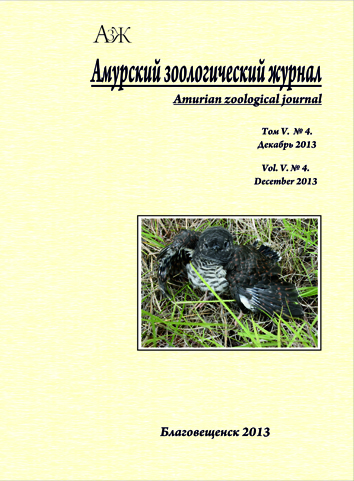COLD HARDINESS POTENTIAL OF THE UPIS CERAMBOIDES (COLEOPTERA: TENEBRIONIDAE) AS A MODEL OF SUMMER INSECTS INHABITING YAKUTIA
DOI:
https://doi.org/10.33910/1999-4079-2013-5-4-391-395Keywords:
Upis ceramboides, Coleoptera, Tenebrionidae, cold hardiness potential, YakutiaAbstract
Ability of Upis ceramboides imago was studied to be resisted to the different ranges of freezing temperatures during hot summer period in Yakutia . It was shown that Upis ceramboides are tolerant to multiply cycles of freezing-thawing at their SCP (supercooling point) and even more, they survived over at least three cycles of freezing-thawing at –15....–17°C, if they were pre-incubated during 14 days at +4°C before laboratory testing. According to the study, one of the reasons of elevating of the insect resistance to such temperature conditions is a deep cleansing of body from occasional ice nucleators appearing in the intestine. It is suggested that in the case of summer frost, the cold tolerance of these species would be based on gut clearing.
References
Гаврилова М.К., 2003 Климаты холодных регионов земли. Якутск. С. 70-87.
Иванова С.С., 2002. Эколого-биохимические аспекты адаптации зимующих насекомых Якутии к низкотемпературным условиям // дисс … канд. биол. наук. Улан-Удэ. 142 с.
Ли Н.Г., 2011. Лед-нуклеирующая активность гемолимфы Upis ceramboides, обитающего в Центральной Якутии // Проблемы криобиологии. Т. 21, № 1. С. 34-46.
Ушатинская Р.С., 1957. Основы холодостойкости насекомых. М.: Академия наук СССР. 314 с.
Baust J.G., Miller L.K., 1970. Seasonal variations in the glycerol content and its influence on cold hardiness in the Alaskan carabid beetle Pterostichus brevicornis // J. Insect Physiology. № 16. P. 979-990.
Baust J.G., Rojas R.R., 2003. Review – insect cold hardiness: facts and fancy // J. Insect Physiol. 1985. V. 31. № 10. Р.755-759.
Jones A., Reed R., Weyers J., 2003. Practical Skills in Biology. UKP. 321 р.
Kristiansen E., Li N.G., Averensky A.I., Zachariassen K.E., 2009. The Siberian timberman Acanthocinus aedilis: a freeze-tolerant beetle with low supercooling points // J Comparative Physiology B: Biochemical, Systemic, and Environmental Physiology. V. 179. P. 563-568.
Lee R.E., Delinger D., 1991. Insects at low temperature. New York : Chapman and Hall. 513 p.
Li N.G., 2012. Relationships between cold hardiness, and ice nucleating activity, glycerol and protein contents in the hemolymph of caterpillars, Aporia crataegi L. // Cryoletters. V. 33(2). P. 134 -142.
Li N.G., Zachariassen K.E., 2007. Cold hardiness of insects distributed in the area of Siberian Cold Pole // J. Comparative Biochemistry and Physiology A: Molecular & Integrative Physiology. V. 146А. P. 156-157.
Margesin R., Schinner F., 1999. Cold adopted organisms. Germany: Springer. P. 138.
Michaud M.R., 2007. Molecular physiology of insect low temperature stress responses // Dissertation. The Ohio State University. 157 p.
Ramlov H., 2000. Aspects of natural cold tolerance in ectothermic animals // Human Reproduction. Vol.15. P. 26-46.
Sidsel van der Laak, 1982. Physiological adaptations to low temperature in freezing-tolerant Phyllodecta laticollis beetles // Comp. Biochem. and Physiol. V. 73A. № 4. P. 613-621.
Sinclair B., Addo-Bediako A., Chown S.L., 2003. Climatic variability and the evolution of insect freeze tolerance // Biol. Rev. 78. P. 181-195.
Somme L., 1982. Supercooling and winter survival in terrestrial arthropods // Comp. Biochem. and Physiol. V. 73A. № 4. P. 519-545.
Somme L., Zachariassen K.E., 1981. Adaptations to low temperature in high latitude insects from Mount Kenya // Ecol. Entomol. № 6. P. 199-204.
Zachariassen K.E., 1985. Physiology of cold tolerance in insects // Physiol. Rev. V. 65. P. 799-832.
Zachariassen K.E., 1992. Ice nucleating agents in coldhardy insects // Water and Life. Ch. 16. P. 261-281.
Zachariassen K.E., Baust J.G., Lee R.J., 1982. A method for quantitative determination of ice nucleating agents in Insect hemolymph // Cryobiology. Vol. 19. P.180-184.
Downloads
Published
Issue
Section
License
Copyright (c) 2013 Н.Г. Ли

This work is licensed under a Creative Commons Attribution-NonCommercial 4.0 International License.
The work is provided under the terms of the Public Offer and of Creative Commons public license Creative Commons Attribution 4.0 International (CC BY 4.0).
This license permits an unlimited number of users to copy and redistribute the material in any medium or format, and to remix, transform, and build upon the material for any purpose, including commercial use.
This license retains copyright for the authors but allows others to freely distribute, use, and adapt the work, on the mandatory condition that appropriate credit is given. Users must provide a correct link to the original publication in our journal, cite the authors' names, and indicate if any changes were made.
Copyright remains with the authors. The CC BY 4.0 license does not transfer rights to third parties but rather grants users prior permission for use, provided the attribution condition is met. Any use of the work will be governed by the terms of this license.







